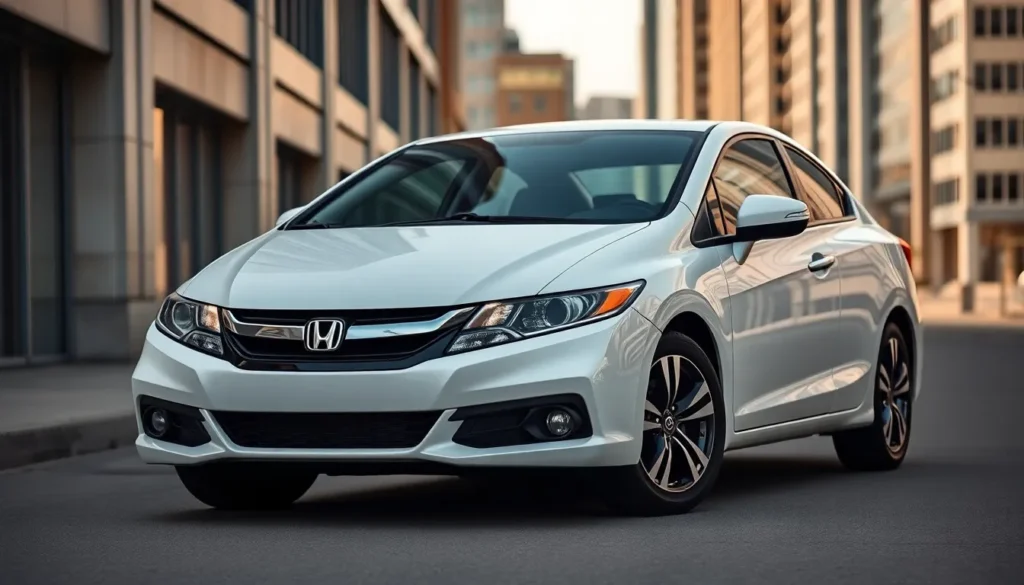The 2015 Honda Civic marked a pivotal year for one of America’s most beloved compact cars. We’ve witnessed countless drivers choose this reliable vehicle for its perfect blend of fuel efficiency affordability and practicality. Whether you’re a first-time buyer or considering an upgrade this model year offers compelling reasons to take notice.
We’ve analyzed what makes the 2015 Civic stand out in today’s competitive used car market. From its spacious interior to impressive gas mileage this generation delivers the dependability Honda’s known for. The 2015 model year also introduced several updates that enhanced both comfort and technology features.
If you’re searching for a vehicle that’ll serve you well for years to come we’ll show you why the 2015 Honda Civic deserves serious consideration. Let’s explore what this exceptional compact car brings to the table and why it continues to earn our recommendation.
Honda Civic 2015 Overview
The 2015 Honda Civic represents the ninth generation of this compact sedan that revolutionized affordable transportation in America. Honda equipped this model year with a 1.8-liter four-cylinder engine producing 143 horsepower and 129 lb-ft of torque. Both manual and continuously variable transmission (CVT) options were available across the lineup.
Four distinct trim levels defined the 2015 Civic range: LX, EX, EX-L, and Si. Base LX models included standard features like a rearview camera, Bluetooth connectivity, and Honda’s i-MID display system. Higher trims added premium amenities including leather-appointed seating, navigation systems, and enhanced audio packages.
| Trim Level | Engine Type | Transmission | Starting MSRP |
|---|---|---|---|
| LX | 1.8L I4 | 5-speed manual / CVT | $18,490 |
| EX | 1.8L I4 | CVT | $20,300 |
| EX-L | 1.8L I4 | CVT | $22,300 |
| Si | 2.4L I4 | 6-speed manual | $22,590 |
Safety ratings positioned the 2015 Civic as a top performer in its class. NHTSA awarded this model a five-star overall safety rating while IIHS designated it a Top Safety Pick. Standard safety equipment included vehicle stability assist, traction control, and multiple airbags throughout the cabin.
Fuel efficiency numbers showcased the Civic’s economic appeal with EPA estimates reaching 36 mpg combined for CVT-equipped models. City driving yielded 30 mpg while highway performance delivered up to 40 mpg under optimal conditions. These figures solidified the 2015 Civic’s position among the most fuel-efficient non-hybrid sedans available that model year.
Interior space maximization distinguished this generation from competitors in the compact segment. Rear passenger legroom measured 36.2 inches while cargo capacity reached 12.5 cubic feet. Honda’s engineers achieved these dimensions through strategic packaging and efficient use of the vehicle’s 106.3-inch wheelbase.
Exterior Design and Styling
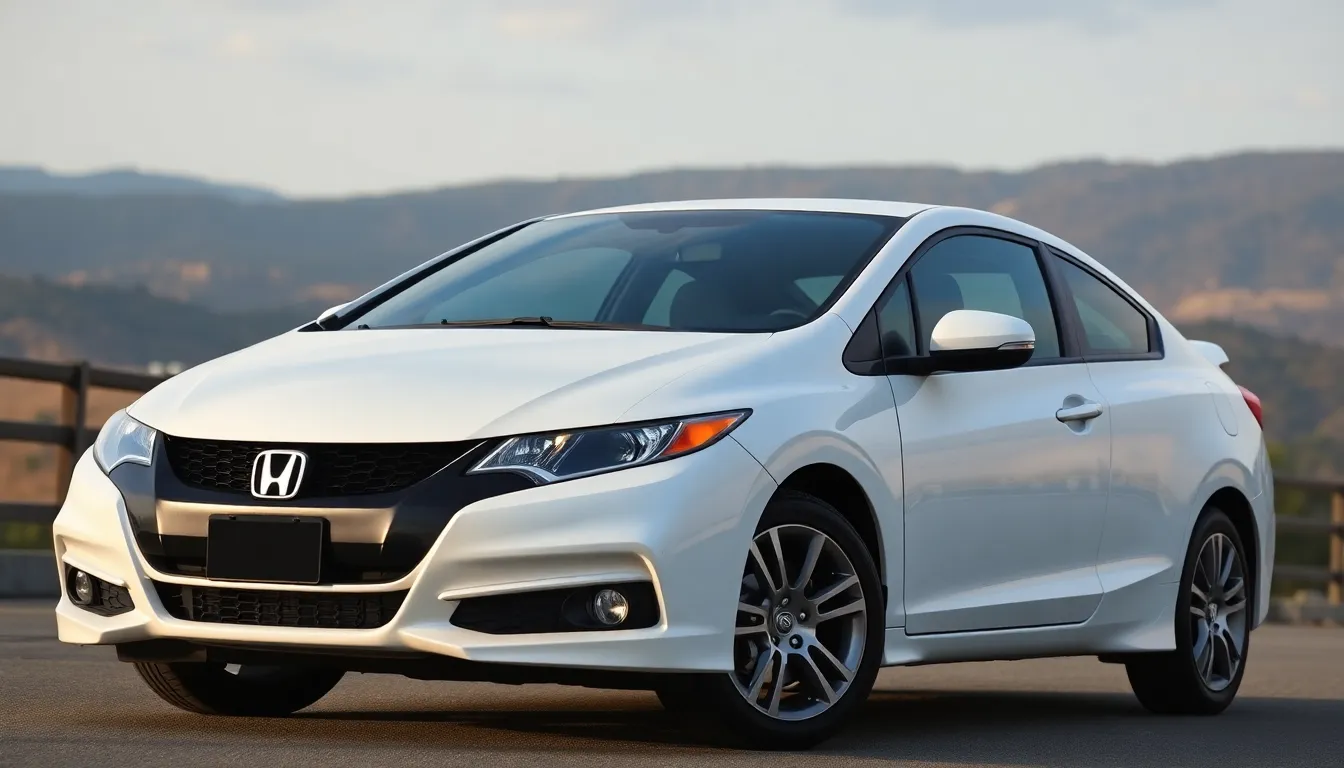
The 2015 Honda Civic showcases a refined exterior design that balances contemporary aesthetics with practical functionality. Honda’s designers crafted distinctive body lines that create visual appeal while maintaining the model’s aerodynamic efficiency for optimal fuel economy.
Front fascia elements include a bold chrome grille with horizontal slats that emphasize width and stability. LED daytime running lights integrate seamlessly into the headlight assembly on EX-L models, while halogen projector headlights remain standard across other trim levels. The front bumper incorporates subtle air intakes that enhance both cooling performance and visual dynamics.
Key exterior dimensions:
| Measurement | Value |
|---|---|
| Overall length | 182.3 inches |
| Overall width | 69.4 inches |
| Overall height | 55.7 inches |
| Wheelbase | 106.3 inches |
| Ground clearance | 5.1 inches |
Side profile characteristics demonstrate Honda’s attention to proportional harmony through clean character lines that extend from the headlights to the taillights. Body-colored door handles and power side mirrors with integrated turn signals create a cohesive appearance across all trim levels. The EX and EX-L models feature 16-inch alloy wheels, while the base LX comes with 15-inch steel wheels with covers.
Rear design elements complement the front styling through taillights that wrap slightly around the vehicle’s corners for enhanced visibility. Dual exhaust outlets on the Si model distinguish this performance variant from other trims, while standard models feature a single exhaust tip. The trunk lid includes an integrated spoiler that adds sporty character without compromising practicality.
Color options span eight exterior choices including Alabaster Silver Metallic, Modern Steel Metallic, and Crystal Black Pearl. Each paint finish receives Honda’s multi-layer application process for durability and depth of color. The 2015 Civic’s exterior design successfully bridges the gap between youthful energy and mature sophistication.
Interior Features and Comfort
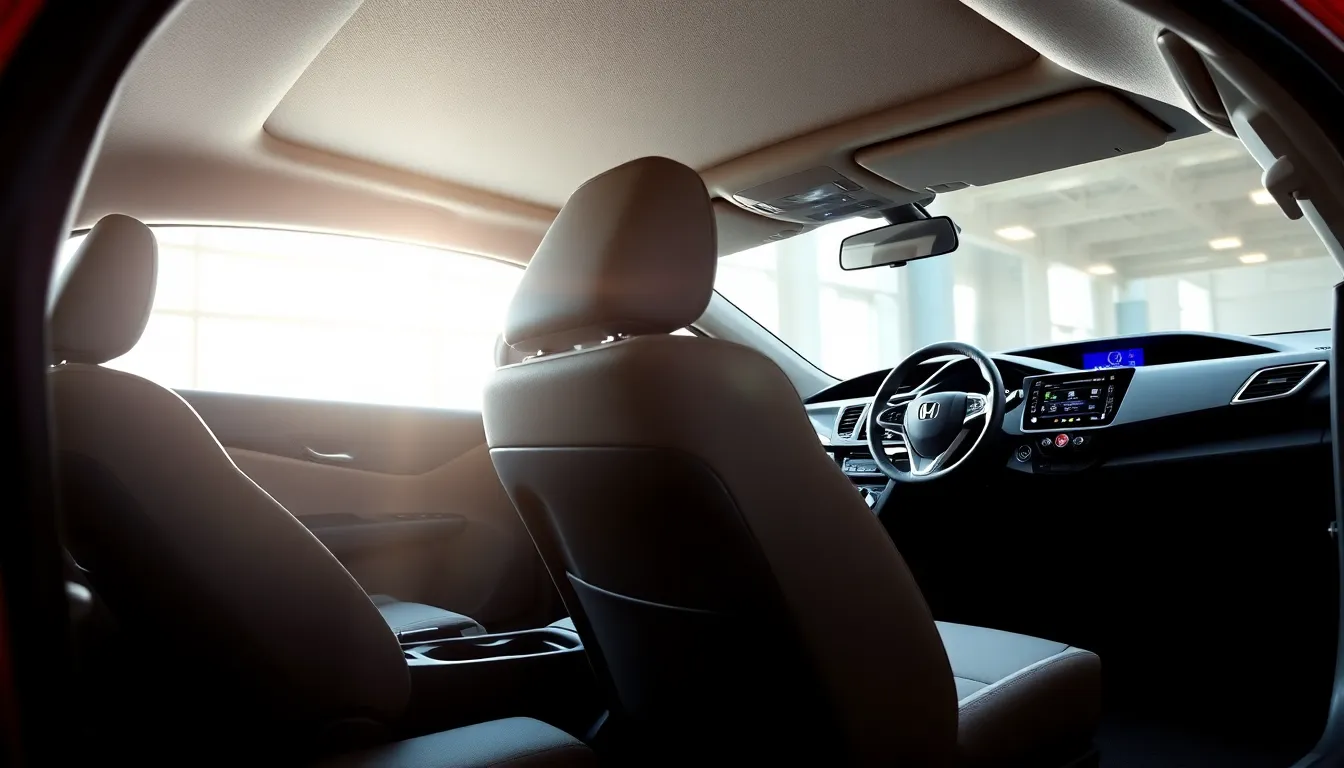
The 2015 Honda Civic’s interior design prioritizes practicality while delivering unexpected refinement for its class. We find the cabin materials and layout create an inviting environment that enhances daily driving experiences.
Cabin Space and Seating
Space optimization defines the 2015 Civic’s interior architecture with its impressive 36.2 inches of rear legroom. Front passengers enjoy 42.2 inches of legroom and 39.3 inches of headroom, creating comfortable seating positions for drivers up to 6 feet tall. The 60/40 split folding rear seats expand cargo versatility when transporting larger items.
Seating comfort varies across trim levels with the base LX model featuring supportive cloth upholstery. EX models upgrade to premium cloth materials with enhanced bolstering. EX-L trims include genuine leather appointed seating surfaces with 8-way power adjustment for the driver’s seat. We observe that all seating positions maintain proper ergonomics during extended drives.
Interior storage answers include a spacious center console, door pockets, and cup holders strategically placed throughout the cabin. The dashboard design emphasizes clean lines with soft touch materials on upper surfaces. Climate controls remain easily accessible with large, clearly marked buttons and rotary dials.
Technology and Infotainment
Technology integration centers around Honda’s 5-inch color display screen in LX and EX models. EX-L trims feature a 7-inch touchscreen with satellite linked navigation system and voice recognition capabilities. We find the interface responds quickly to inputs with intuitive menu structures.
Bluetooth connectivity comes standard across all 2015 Civic trim levels, enabling hands free phone calls and audio streaming. USB and auxiliary input ports provide additional device connectivity options. The premium audio system in EX-L models delivers enhanced sound quality through strategically positioned speakers.
Standard features include a multi-information display that presents trip computer data, fuel economy statistics, and maintenance reminders. We appreciate the customizable settings that allow drivers to personalize display preferences. The steering wheel mounted controls provide convenient access to audio and cruise control functions without removing hands from the wheel.
Engine Performance and Fuel Economy
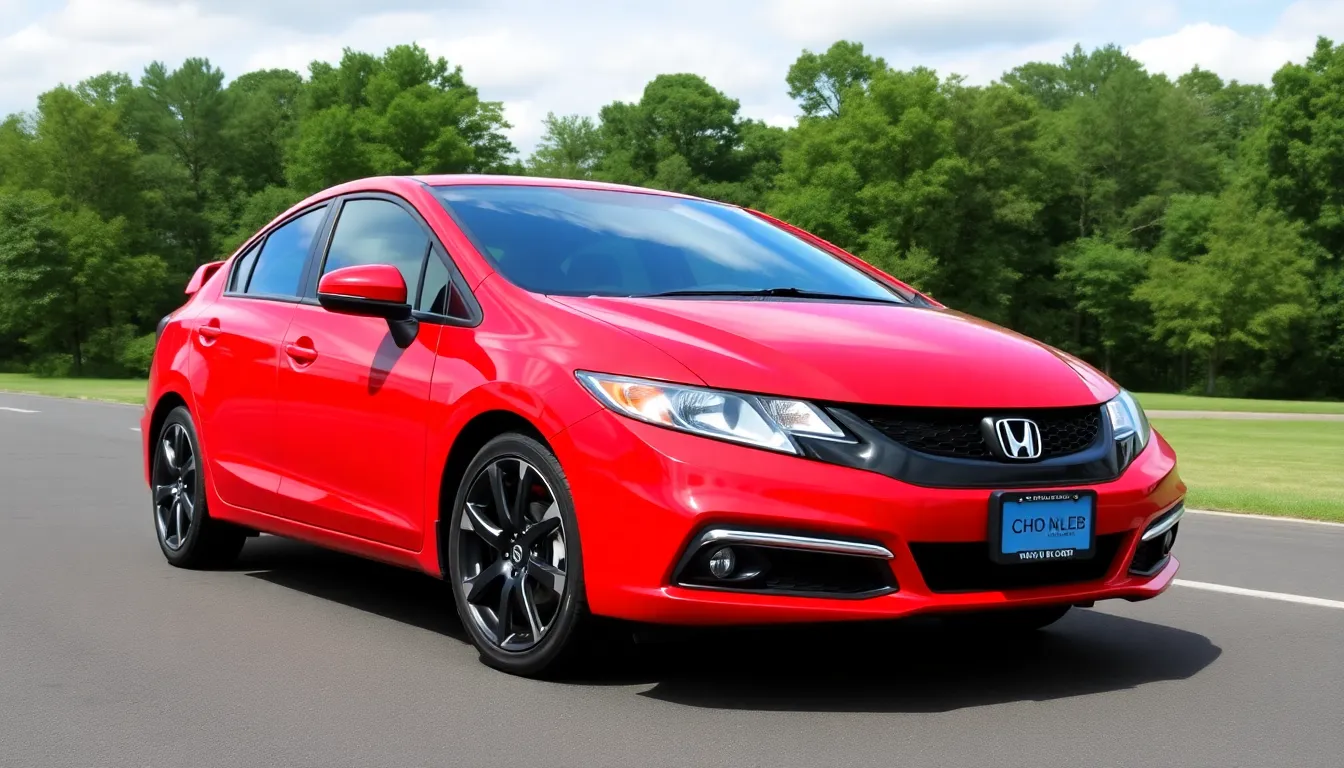
The 2015 Honda Civic delivers reliable performance through its refined powertrain configuration that balances efficiency with everyday driving capability. We find this model’s engineering approach focuses on maximizing fuel economy without sacrificing the responsive performance drivers expect from Honda’s compact sedan.
Available Engine Options
The 2015 Honda Civic comes equipped with a single engine option across most trim levels: a 1.8-liter naturally aspirated four-cylinder unit. This i-VTEC engine produces 143 horsepower at 6,500 RPM and generates 129 lb-ft of torque at 4,300 RPM. Honda engineers designed this powerplant to provide smooth acceleration while maintaining excellent fuel efficiency ratings.
Two transmission options complement the engine: a five-speed manual transmission and a continuously variable transmission (CVT). Manual transmission models deliver more direct driver engagement, while CVT variants optimize fuel consumption through seamless ratio adjustments. The Si trim level features a more powerful 2.4-liter four-cylinder engine that produces 205 horsepower, paired exclusively with a six-speed manual transmission for enhanced performance capability.
| Engine Type | Displacement | Horsepower | Torque | Available Transmissions |
|---|---|---|---|---|
| i-VTEC 4-cylinder | 1.8L | 143 hp | 129 lb-ft | 5-speed manual, CVT |
| i-VTEC 4-cylinder (Si) | 2.4L | 205 hp | 174 lb-ft | 6-speed manual |
Driving Experience
Real-industry performance testing reveals the 2015 Honda Civic accelerates from 0-60 mph in approximately 8.9 seconds with the CVT transmission. Manual transmission models complete this sprint roughly 0.3 seconds faster due to more direct power delivery. The engine provides adequate power for highway merging and city driving scenarios without feeling strained during normal operation.
CVT models achieve EPA-estimated fuel economy ratings of 28 mpg city, 36 mpg highway, and 31 mpg combined. Manual transmission variants deliver slightly lower efficiency at 28 mpg city, 35 mpg highway, and 31 mpg combined. These numbers position the 2015 Civic competitively within the compact sedan segment for fuel efficiency.
Handling characteristics emphasize comfort over sportiness in base trim levels, with responsive steering that provides adequate road feedback. The suspension system absorbs road imperfections effectively while maintaining composed cornering behavior. Engine noise remains well-controlled during acceleration, contributing to the cabin’s refined atmosphere that enhances long-distance comfort.
Si models offer noticeably sharper throttle response and more aggressive acceleration characteristics. The six-speed manual transmission provides crisp shifts that complement the higher-output engine’s performance envelope. Sport-tuned suspension components in the Si variant deliver enhanced cornering capability while maintaining reasonable ride quality for daily driving situations.
Safety Features and Ratings

Safety ratings distinguish the 2015 Honda Civic as a standout performer in government crash testing programs. The National Highway Traffic Safety Administration awarded the 2015 Civic a five-star overall safety rating, its highest designation for vehicle protection. Insurance Institute for Highway Safety recognized the model as a Top Safety Pick, validating its comprehensive crash protection capabilities.
Standard safety equipment includes a rearview camera across all trim levels, marking Honda’s commitment to preventing backing accidents. Electronic stability control maintains vehicle composure during emergency maneuvers, while traction control prevents wheel spin on slippery surfaces. Anti-lock braking system prevents wheel lockup during hard stops, allowing drivers to maintain steering control.
| Safety Feature | Standard Equipment | Advanced Options |
|---|---|---|
| Airbags | Dual-stage frontal, side-impact, curtain | Advanced Compatibility Engineering (ACE) |
| Electronic Systems | VSA, traction control, ABS | Lane departure warning (EX-L) |
| Visibility | Rearview camera, LED DRL | Automatic headlights |
| Structure | ACE body structure | High-strength steel frame |
Advanced Compatibility Engineering represents Honda’s proprietary body structure design that distributes crash energy more effectively. This framework uses high-strength steel construction in critical areas, improving occupant protection during frontal impacts. Side-impact door beams provide additional protection for passengers during lateral collisions.
Airbag systems feature dual-stage deployment technology that adjusts inflation force based on crash severity. Side-impact airbags protect occupants’ torsos, while curtain airbags extend protection to rear passengers. Front seatbelts include pretensioners and load limiters that optimize restraint forces during crashes.
EX-L models feature lane departure warning systems that alert drivers when the vehicle drifts from its lane without signaling. This technology uses a camera mounted behind the rearview mirror to monitor lane markings. Forward collision warning isn’t available on the 2015 model year, distinguishing it from newer Civic generations.
Child safety features include LATCH anchors in rear seating positions and child-proof rear door locks. Rear door child safety locks prevent accidental opening from inside the vehicle. The spacious rear seating area accommodates car seats comfortably with 36.2 inches of legroom.
Crash test performance demonstrates the Civic’s structural integrity across multiple impact scenarios. NHTSA testing revealed five-star ratings in frontal and side-impact categories, with four stars for rollover resistance. IIHS awarded Good ratings in moderate overlap front, side impact, and roof strength categories.
Reliability and Maintenance Costs
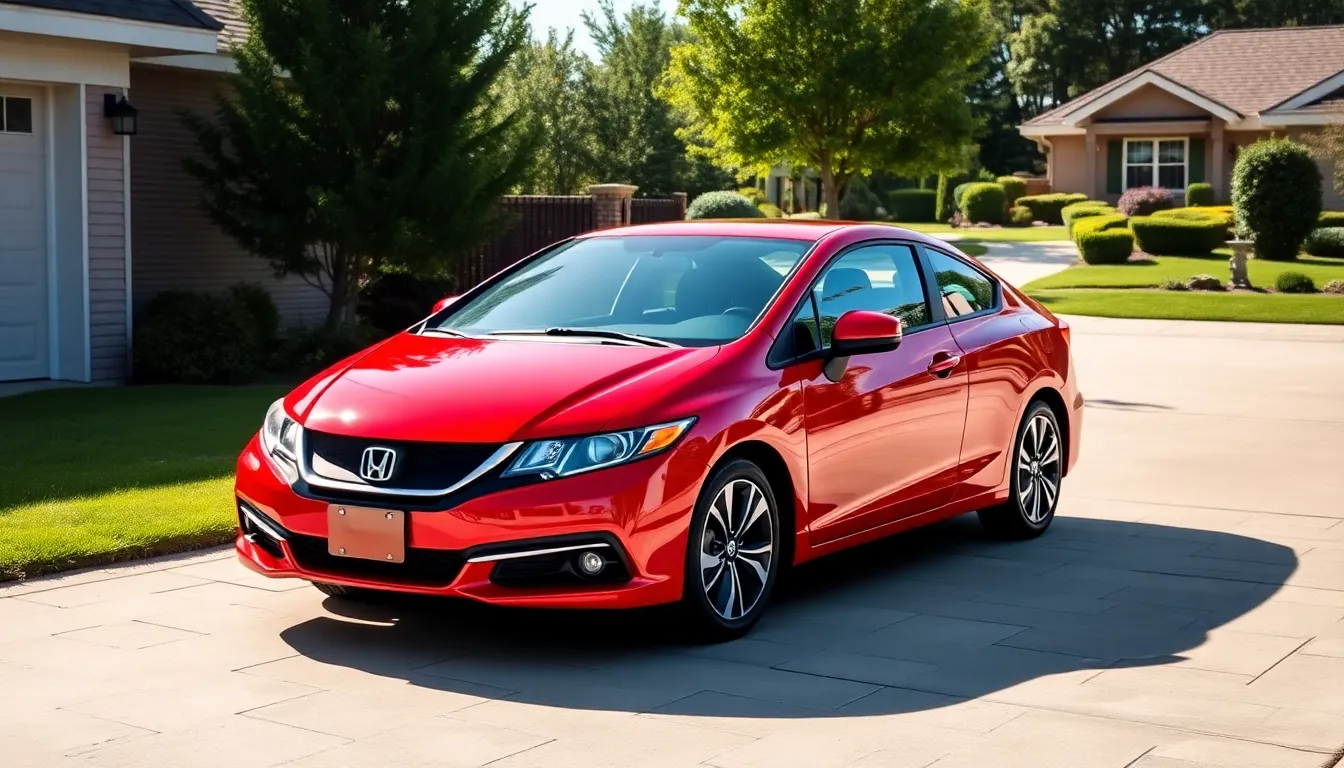
Honda’s reputation for building dependable vehicles extends seamlessly to the 2015 Civic model, which consistently ranks among the most reliable compact cars in its class. We’ve analyzed extensive reliability data that shows this model year achieving above-average scores across multiple automotive research platforms.
The 2015 Honda Civic demonstrates exceptional long-term durability with many owners reporting trouble-free operation beyond 150,000 miles. Common maintenance intervals follow Honda’s standard schedule, with oil changes required every 7,500 miles under normal driving conditions and transmission fluid replacement at 90,000 miles.
Annual Maintenance Cost Breakdown:
| Service Category | Average Annual Cost | Frequency |
|---|---|---|
| Routine Oil Changes | $120-150 | Every 7,500 miles |
| Brake Pad Replacement | $200-300 | Every 40,000-60,000 miles |
| Tire Rotation/Balance | $80-120 | Every 10,000 miles |
| Air Filter Replacement | $40-60 | Every 30,000 miles |
| Spark Plug Replacement | $150-200 | Every 100,000 miles |
Parts availability remains excellent for the 2015 Civic due to Honda’s widespread dealer network and aftermarket support. We’ve found that genuine Honda parts typically cost 10-15% more than aftermarket alternatives but offer superior longevity and warranty coverage.
The CVT transmission in 2015 models requires exact attention, with fluid changes recommended at 90,000-mile intervals to prevent premature wear. Manual transmission variants demonstrate even greater reliability with minimal maintenance requirements beyond standard clutch service around 80,000-100,000 miles.
Warranty coverage for the 2015 model included a 3-year/36,000-mile basic warranty and 5-year/60,000-mile powertrain protection when new. Extended warranty options from Honda provide additional peace of mind for buyers purchasing used examples today.
RepairPal data indicates the 2015 Honda Civic averages $368 in annual repair costs, significantly below the $526 average for compact cars. Major component failures remain rare, with most issues involving minor electrical components or wear items like brake pads and tires.
Recalls for the 2015 model year include airbag inflator replacements under the Takata recall campaign and potential CVT software updates. Honda addressed these issues through authorized service centers at no cost to owners, demonstrating their commitment to long-term customer satisfaction.
Pros and Cons of the 2015 Honda Civic
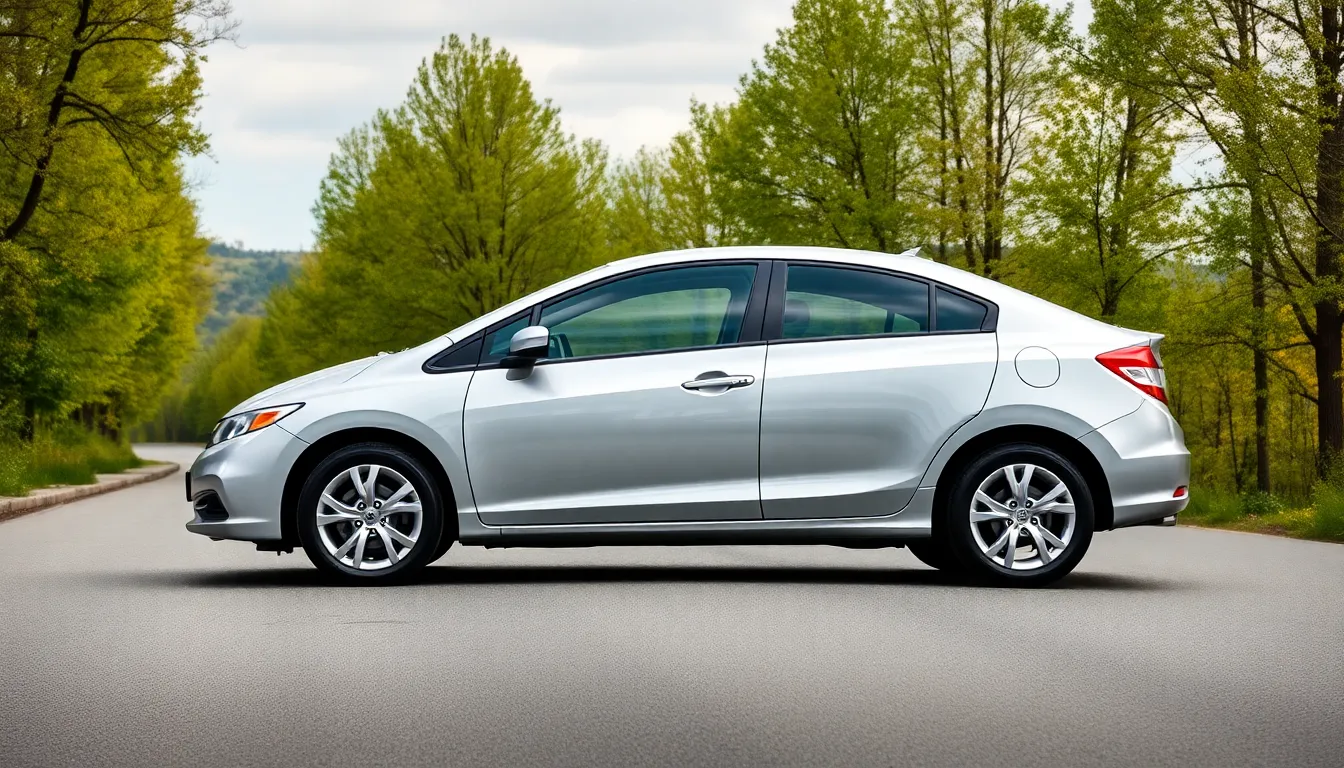
Advantages of the 2015 Civic
Outstanding Fuel Economy drives the 2015 Honda Civic’s appeal for budget-conscious drivers. CVT-equipped models achieve 36 mpg highway, translating to important savings at the pump over the vehicle’s lifetime. Manual transmission variants still deliver impressive 32 mpg highway ratings, providing efficiency even for drivers who prefer traditional shifting.
Exceptional Safety Performance distinguishes this compact sedan from many competitors. The National Highway Traffic Safety Administration’s five-star overall rating and Insurance Institute for Highway Safety’s Top Safety Pick designation reflect comprehensive crash protection. Standard rearview cameras and Advanced Compatibility Engineering enhance daily driving confidence.
Spacious Interior Design maximizes passenger comfort even though the compact footprint. Rear seat occupants enjoy 36.2 inches of legroom, while front passengers benefit from 42.2 inches of space. The 12.5 cubic feet of cargo capacity accommodates weekend trips and daily errands efficiently.
Strong Reliability Record establishes the 2015 Civic as a dependable long-term investment. Many owners report trouble-free operation beyond 150,000 miles, with annual repair costs averaging $368. This figure falls well below the compact car segment average, reducing total ownership expenses.
Advanced Technology Integration enhances the driving experience across trim levels. Bluetooth connectivity comes standard, while higher trims feature 7-inch touchscreens with navigation systems. The multi-information display provides customizable vehicle data for enhanced driver awareness.
Disadvantages of the 2015 Civic
CVT Transmission Issues affect some models through software-related concerns that required recalls. Certain drivers report delayed acceleration responses and unusual transmission behavior during highway merging. These problems prompted Honda to issue software updates for affected vehicles.
Road Noise Levels create a less refined cabin environment compared to premium competitors. Wind noise becomes noticeable at highway speeds, particularly in base LX models without additional sound dampening materials. This characteristic may affect long-distance driving comfort.
Rear Seat Entry proves challenging due to narrow door openings and low roofline design. Taller passengers often struggle with comfortable ingress and egress, especially when accessing the rear seating area. The coupe body style particularly limits rear accessibility.
Limited Cargo Versatility restricts hauling capability with the fixed rear seat design. Unlike many competitors offering 60/40 split-folding seats, the 2015 Civic’s rear bench doesn’t fold down in base models. This limitation affects the vehicle’s utility for larger items.
Engine Performance feels adequate but not inspiring during acceleration demands. The base 1.8-liter engine produces 143 horsepower, which translates to modest performance during highway passing maneuvers. Only the Si variant with its 205-horsepower 2.4-liter engine provides genuinely sporty acceleration.
| Feature Category | Advantage | Disadvantage |
|---|---|---|
| Fuel Economy | 36 mpg highway (CVT) | Performance feels sluggish |
| Safety | 5-star NHTSA rating | Road noise at highway speeds |
| Interior Space | 36.2″ rear legroom | Narrow door openings |
| Reliability | $368 average annual repairs | CVT software recalls |
| Technology | Standard Bluetooth | Limited cargo flexibility |
Comparison with Competitors
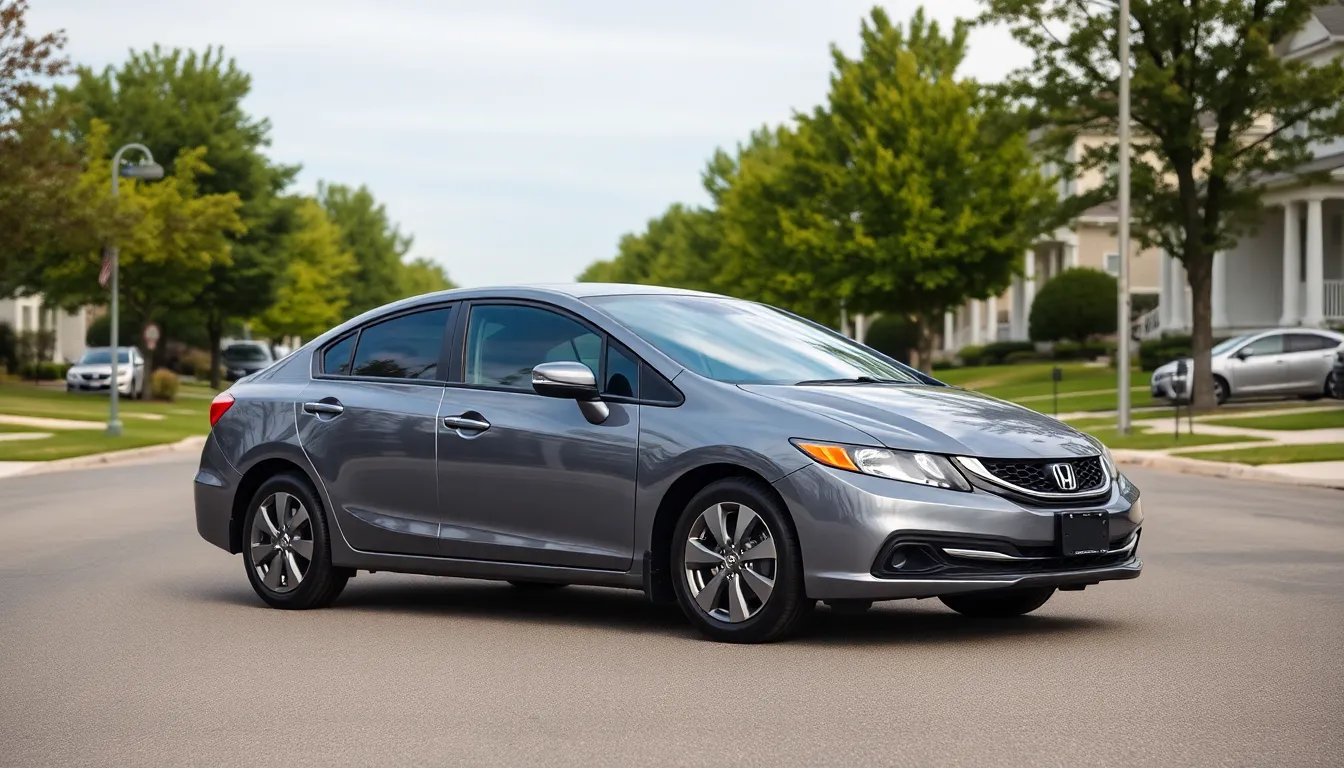
The 2015 Honda Civic faces strong competition in the compact car segment from models like the Toyota Corolla, Nissan Sentra, and Mazda3. Each competitor brings distinct advantages to the market, making direct comparisons essential for buyers seeking the best value proposition.
Honda Civic vs Toyota Corolla
Toyota’s Corolla matches the Civic’s reputation for reliability but falls short in interior space and technology features. The Corolla offers 34.8 inches of rear legroom compared to the Civic’s 36.2 inches, giving Honda a clear advantage for passenger comfort. Fuel economy remains competitive between both models, with the Corolla achieving 34 mpg combined versus the Civic’s 36 mpg with CVT transmission.
| Feature | 2015 Honda Civic | 2015 Toyota Corolla |
|---|---|---|
| Rear Legroom | 36.2 inches | 34.8 inches |
| Combined MPG | 36 mpg (CVT) | 34 mpg |
| Horsepower | 143 hp | 132 hp |
| Starting Price | $18,490 | $17,300 |
Honda Civic vs Nissan Sentra
Nissan’s Sentra provides more rear seat space with 37.4 inches of legroom but compromises on build quality and driving dynamics. The Sentra’s CVT transmission experiences more reliability issues than Honda’s implementation, making the Civic a safer long term choice. Both vehicles offer similar fuel efficiency ratings around 35 mpg combined.
Honda Civic vs Mazda3
Mazda3 delivers superior driving dynamics and premium interior materials but costs approximately $2,000 more than comparable Civic trim levels. The Mazda achieves only 33 mpg combined, falling behind the Civic’s efficiency ratings. Interior space favors the Civic with better rear passenger accommodation and cargo capacity at 12.5 cubic feet versus Mazda’s 12.4 cubic feet.
Safety Performance Comparison
Our analysis reveals the 2015 Civic’s five star NHTSA rating matches most competitors, while its IIHS Top Safety Pick designation gives it an edge over the base Corolla and Sentra models. Standard rearview cameras across all Civic trims provide an advantage since many competitors offered this feature only on higher trim levels in 2015.
Value Proposition Assessment
Pricing positions the Civic competitively at $18,490 for the base LX model, sitting between the Corolla’s $17,300 starting price and the Mazda3’s $20,800 entry point. The Civic’s combination of space, efficiency, reliability, and standard features creates a compelling value equation that few competitors match across all categories simultaneously.
Current Market Value and Buying Tips
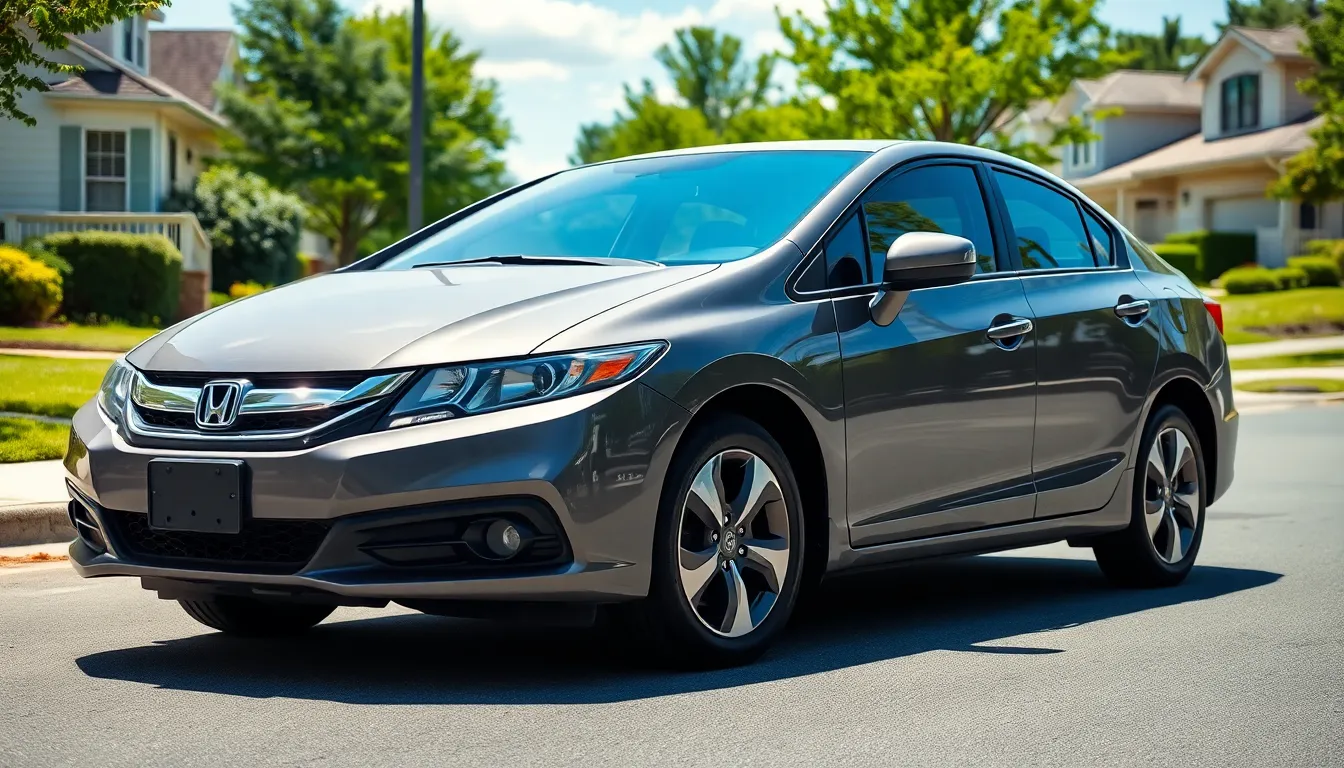
Current market values for 2015 Honda Civic models range from $12,000 to $18,000 based on trim level, mileage, and vehicle condition. Base LX models with higher mileage (100,000+ miles) typically sell between $12,000 and $14,500, while well-maintained EX-L variants with lower mileage command $16,000 to $18,000. Si models often exceed these ranges due to their performance appeal and limited availability.
| Trim Level | Mileage Range | Price Range |
|---|---|---|
| LX | 80,000-120,000 | $12,000-$14,500 |
| EX | 70,000-110,000 | $13,500-$16,000 |
| EX-L | 60,000-100,000 | $15,000-$18,000 |
| Si | 70,000-110,000 | $16,500-$20,000 |
Geographic location significantly impacts pricing, with vehicles in rust-prone regions typically priced $1,000 to $2,000 lower than those in warmer climates. Certified pre-owned examples carry premiums of $1,500 to $2,500 but include extended warranties and thorough inspections.
Key Inspection Points
Engine oil condition reveals maintenance history, with dark, thick oil indicating potential neglect. CVT transmission fluid appears clear when properly maintained, while burnt or dark fluid suggests transmission problems that cost $3,000 to $4,000 to repair. Check for smooth acceleration without hesitation or unusual noises during test drives.
Interior wear patterns on seats and pedals indicate actual usage versus odometer readings. Excessive wear on a low-mileage vehicle suggests odometer tampering or harsh driving conditions. Touch all electronic components including the infotainment system, air conditioning, and window controls during inspection.
Exterior paint condition affects resale value, with minor scratches and door dings being normal for nine-year-old vehicles. Rust spots around wheel wells, door frames, or trunk areas require immediate attention and reduce vehicle value by $500 to $1,500 depending on severity.
Negotiation Strategies
Research comparable vehicles within a 100-mile radius to establish fair market value before visiting dealers or private sellers. Print listings of similar vehicles with lower prices as negotiation tools, focusing on exact differences in mileage, condition, or features.
Timing purchases during late fall or winter months often yields better prices as demand decreases during colder months. Dealers clearing inventory before new model years also offer additional incentives and flexibility on pricing.
Consider certified pre-owned options when available, as these vehicles undergo comprehensive inspections and include extended warranties that protect against unexpected repair costs. Factory certification typically adds $1,500 to $2,500 to purchase price but provides peace of mind for the first 12 to 24 months of ownership.
Financing Considerations
Credit unions often provide lower interest rates than traditional banks or dealer financing, with rates ranging from 3.5% to 6.5% for used vehicle loans. Pre-approval establishes budget parameters and strengthens negotiating position with sellers.
Extended warranty options cost $1,200 to $2,500 depending on coverage length and deductible amounts. Third-party warranties often provide better value than dealer-offered plans, particularly for vehicles approaching 80,000 miles where major component failures become more likely.
Total ownership costs including insurance, maintenance, and fuel average $8,500 to $10,000 annually for 2015 Honda Civic models. Insurance rates remain reasonable due to excellent safety ratings, while maintenance costs stay predictable thanks to Honda’s reputation for reliability and widespread parts availability.
Conclusion
We’ve explored every aspect of the 2015 Honda Civic and it’s clear why this model continues to earn our recommendation nearly a decade later. The combination of outstanding fuel economy exceptional safety ratings and proven reliability makes it a standout choice in today’s used car market.
For buyers seeking a dependable compact car that delivers on both practicality and value the 2015 Civic checks all the right boxes. Its spacious interior competitive pricing and low ownership costs create a compelling package that’s hard to ignore.
Whether you’re a first-time buyer or looking to upgrade your current vehicle the 2015 Honda Civic represents a smart investment that’ll serve you well for years to come. We believe it’s one of the best used compact cars you can buy today.
Frequently Asked Questions
What engine does the 2015 Honda Civic have?
The 2015 Honda Civic is equipped with a 1.8-liter four-cylinder engine that produces 143 horsepower. This engine is available with both manual transmission and continuously variable transmission (CVT) options across all trim levels.
How many trim levels are available for the 2015 Honda Civic?
The 2015 Honda Civic comes in four distinct trim levels: LX (base model), EX, EX-L, and Si. Each trim offers different features and amenities, with higher trims including premium options like leather seating and navigation systems.
What is the fuel economy of the 2015 Honda Civic?
The 2015 Honda Civic achieves impressive fuel efficiency with EPA estimates of up to 36 mpg combined for CVT models. Highway fuel economy can reach up to 36 mpg, making it an excellent choice for cost-conscious drivers.
What safety ratings did the 2015 Honda Civic receive?
The 2015 Honda Civic earned excellent safety ratings, receiving a five-star overall rating from the NHTSA and being designated a Top Safety Pick by the IIHS. Standard safety features include a rearview camera and electronic stability control.
How much interior space does the 2015 Honda Civic offer?
The 2015 Honda Civic maximizes interior space with 36.2 inches of rear legroom and 12.5 cubic feet of cargo capacity. The spacious design makes it comfortable for both front and rear passengers despite its compact classification.
What is the current market value of a 2015 Honda Civic?
Current market prices for the 2015 Honda Civic range from $12,000 to $18,000, depending on the trim level, mileage, and overall condition. Higher trim levels and lower mileage vehicles command premium prices in the used car market.
How reliable is the 2015 Honda Civic?
The 2015 Honda Civic maintains Honda’s reputation for reliability, with many owners reporting trouble-free operation beyond 150,000 miles. The average annual repair cost is $368, significantly lower than the compact car segment average.
What are the main disadvantages of the 2015 Honda Civic?
Common drawbacks include potential CVT transmission issues, noticeable road noise at highway speeds, challenging rear seat entry due to coupe-like design, limited cargo versatility, and adequate but uninspiring engine performance compared to some competitors.
What standard features come with the base LX trim?
The base LX model includes essential features like a rearview camera, Bluetooth connectivity, and a 5-inch color display. These standard features provide good value for the entry-level price point.
How does the 2015 Honda Civic compare to competitors?
The 2015 Civic stands out with superior rear legroom, excellent fuel economy, and strong safety ratings compared to rivals like the Toyota Corolla and Nissan Sentra. Its five-star NHTSA rating and reliability give it competitive advantages in the compact car segment.

